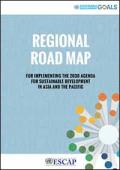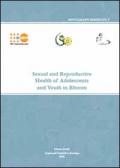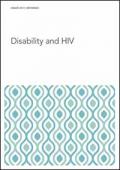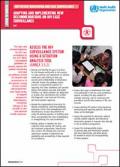What's New
Displaying results 1881 - 1890 of 4914

Resource | Publications,
The Sustainable Development Goals Report 2017 reviews progress made towards the 17 Goals in the second year of implementation of the 2030 Agenda for Sustainable Development. The report is based on the latest available data. It highlights both gains and challenges as the international community moves towards full realization of the ambitions and principles espoused in the 2030 Agenda.
While considerable progress has been made over the past decade across all areas of development, the pace of progress observed in previous years is insufficient to fully meet the Sustainable Development Goals (SDGs) and targets by 2030. Time is therefore of the essence. Moreover, as the following pages show, progress has not always been equitable. Advancements have been uneven across regions, between the sexes, and among people of different ages, wealth and locales, including urban and rural dwellers. Faster and more inclusive progress is needed to accomplish the bold vision articulated in the 2030 Agenda.

Resource | Publications,
Implementation of the Sustainable Development Goals requires national, regional and international cooperative endeavours. The aim of this regional road map is to facilitate cooperation at the regional level, supported by the secretariat and other United Nations entities through the Asia-Pacific Regional Coordination Mechanism as appropriate.
The road map places particular emphasis on supporting the implementation of the 2030 Agenda for Sustainable Development by developing countries, in particular by least developed countries, landlocked developing countries, small island developing States, countries in conflict situations and post-conflict countries and other countries with special needs.
In line with the 2030 Agenda, the objective of the road map is to promote the balanced integration of the three dimensions of sustainable development through regional cooperation in a set of priority areas that support effective pursuit of sustainable development by member States.

Resource | Guidelines,
Based on the WHO "Consolidated guidelines on HIV testing services" that recommend training lay providers in using rapid diagnostic tests, independently to conduct safe and effective HIV testing services, innovative service delivery approaches in "Nepal HlVision 2020" include intensified testing to reach key populations through facility-based outreach and community-led in-reach; linking testing to treatment.
Since the inception of Nepal's anti-retroviral treatment (ART) programme in 2004, under the leadership of the Ministry of Health, National Centre for AIDS and STD Control, the country has taken many measures to scale up ART with the objective of reaching everyone who needs treatment. Development of these "National HIV Testing and Treatment Guidelines 2017" is another milestone.
Following the directives of the National HIV Strategic Plan 2016-2021, these Guidelines support the Test, Treat and Retain continuum, based on the "WHO Consolidated Guidelines on the use of Antiretroviral Drugs for treating and preventing HIV infection", published in 2016. 'Test-and Treat' keeps infected people healthy and living longer, and dramatically reduces the risk of HIV transmission to others.

Resource | Publications,
This study is an effort to explore in depth the young people's sexual and reproductive health issues. It is expected to elicit interest from the politicians, policy makers and international partners, and stimulate public discussions on the youth issues, challenges and concerns. The report is also expected to provide guidance in designing policy interventions.
The report includes topics on the 'quantitative analysis of adolescent sexual and reproductive health issues using the NHS (2012) data', 'retrospective analysis of the hospital-based records of early age pregnancy' and 'qualitative analysis of sexual attitude and behavior of young people in Bhutan'.

Resource | Publications,
In 2016, GNP+ worked diligently to reinvigorate our activist voice and expand our partnerships and programming, while continuing our core capacity building work with PLHIV and key population networks around the world. The highlight of the year, undoubtedly, was our successful 2016 Positive LIVING Leadership Summit which brought together over 270 people living with HIV from 78 countries to engage in two days of intensive discussion, sharing, learning, celebrating and strategizing prior to the 2016 International AIDS conference in Durban. The participants in the Summit forged new partnerships, strengthened old and existing relationships and are now embarking on ambitious advocacy initiatives to address stigma and discrimination and fight for universal access to treatment, care and prevention initiatives for and led by people living with HIV.
Although we remain a small organization, we endeavor to make a large impact in our collective fight to ensure the rights, health, safety and wellness of people living with HIV and empower members of our communities to strengthen their representation and voice in local, national and international policy and programmatic arenas.

Resource | Publications,
In early 2013, the National HIV Monitoring and Evaluation Plan 2013-2017 was developed to compliment the National HIV Strategic Plan (NSP) 2013-2017, and guide the implementation of the NSP’s Strategic Direction 3 – Strategic Information Management Systems. This document provides an updated M&E Plan for the 2016-2018 period, incorporating recommendations from the Mid-Term Review (MTR) of the NSP 2013-2017, and two in-depth Monitoring and Evaluation System Strengthening Assessments, one focused on the health sector HIV response and one focused on the multi-sectorial HIV response.
This document is for all M&E and program staff involved in the National HIV/STI response, including partners in other units of the Ministry of Health, and other Government line ministries. In addition, the document will be useful for national and international partners and funders of HIV/STI activities.

Resource | Publications,
HRP has been providing leadership on sexual and reproductive health and rights for over 40 years. Founded in 1972, we have a unique mandate within the United Nations (UN) system to lead research and to build research capacity for improving sexual and reproductive health and rights through generating high-quality evidence.
HRP’s vision is the attainment of the highest possible level of sexual and reproductive health for every single person across the globe. We strive for a world where human rights that enable sexual and reproductive health are safeguarded, and where all people have access to quality sexual and reproductive health information and services.

Resource | Tools,
Health inequality monitoring should be a central component of national health information systems. Surprisingly, however, national health information systems often neglect to capture within-country inequalities. Sometimes this can be addressed by more effectively communicating existing analyses and underlying disaggregated data to the appropriate target audiences.
This manual serves as a step-by-step practical reference to support countries in building capacity for integrating health inequality monitoring into their health information systems. It presents a range of World Health Organization tools and resources developed for measuring and reporting health inequality. As such, this manual aims to contribute to improved monitoring of health inequalities in countries, a practice that is essential to ensure accountability for the goals and targets of the United Nations 2030 Agenda for Sustainable Development.

Resource | Publications,
This report highlights existing key evidence on the relationship between disability and HIV. It discusses the concrete steps needed for a person-centred, disability-inclusive HIV response that allows for increased participation of people with disabilities and integrates rehabilitation within the continuum of HIV care.
While the Millennium Development Goals were silent on disability, the new Sustainable Development Goals feature a strong will to “leave no one behind”, including people with disabilities. Similarly, the United Nations Convention on the Rights of Persons with Disabilities (CRPD) (3) calls on state parties to ensure the rights of people with disabilities to participate and be included in all spheres of life, including specific articles relating to the right to access health services, including sexual and reproductive health, and rehabilitation services. CRPD also recognizes that "women and girls with disabilities are at greater risk" and need specific protection from negligence and violence.

Resource | Publications,
The tools and recommendations for HIV case surveillance in the 2017 WHO Consolidated guidelines on person-centred HIV patient monitoring and case surveillance should be adopted and customized to fit the specific setting of each country and programme; most importantly, to support programme improvement, strengthen linkages in the cascade of care and optimize health outcomes.





